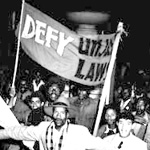This Day in History: October 18, 1952
Additional Date: October 18, 1952
The first violence during the Defiance Campaign erupted in New Brighton, near Port Elizabeth. According to reports the riots followed after a Black person was shot dead by a railway policeman on the New Brighton railway station. People from the nearby 'location' rushed to the scene and, on hearing that a man has been killed, started stoning the station buildings. Police reinforcements arrived and opened fire on the crowd, killing seven people. After that, the mob retreated from the station and surged into the streets. In the rioting that followed, four White people were killed. The Campaign of Defiance of Unjust Laws (commonly known as Defiance Campaign) started on 26 June 1952 as a joint venture of the African National Congress (ANC) and the South African Indian Congress (SAIC). From this date planned acts of defiance of unjust laws were committed by bands of volunteers in all the main centres of the Union. The initial stage of the campaign was noted for its total lack of violence. After violence had erupted in New Brighton, it spread across the country, especially to Johannesburg, Kimberley and East London. The most horrifying incident took place in November in East London, where enraged Blacks killed two White people, one of then a Dominican nun whose body was mutilated. The police retaliated with fire and many people were killed. The government banned fifty-two people, including Nelson Mandela and the newly elected president-general of the ANC, Chief Albert Luthuli. Towards the end of November 1952, the minister of justice, C.R. Swart, issued a proclamation banning all meetings of more than ten Africans anywhere in the country. The campaign petered out towards the end of 1952 with 8 577 activists, mostly from the Eastern Cape, having been arrested. The government reacted to the campaign by enacting the Criminal Law Amendment Act and the Public Safety Act in January 1953, which made future protest virtually impossible.
